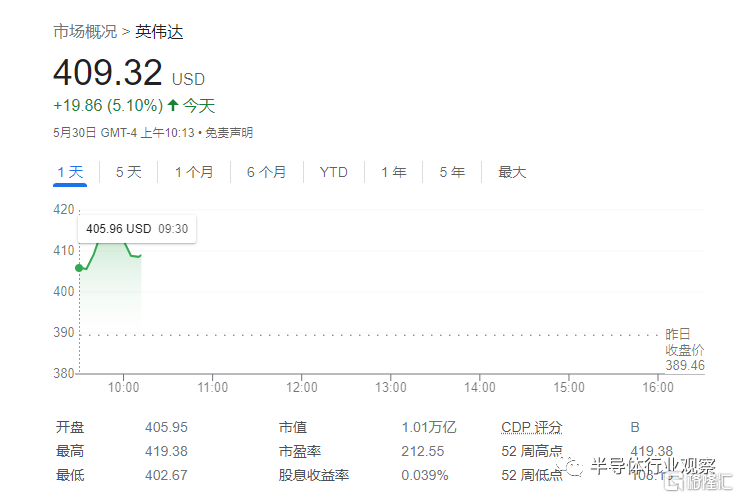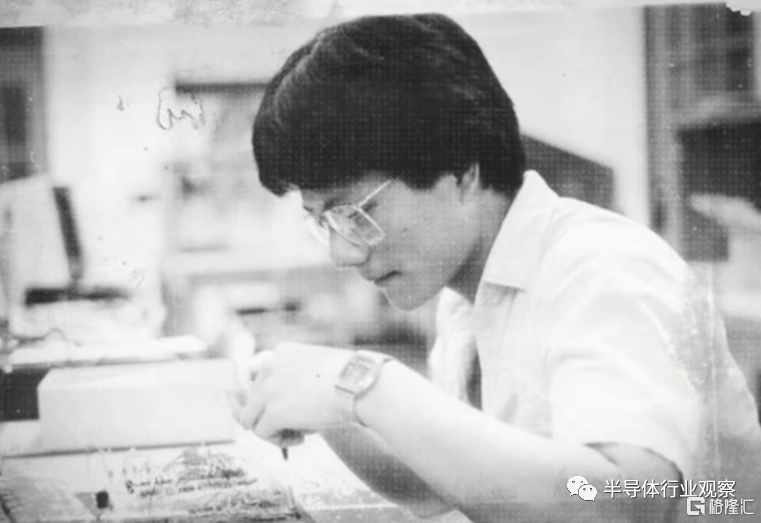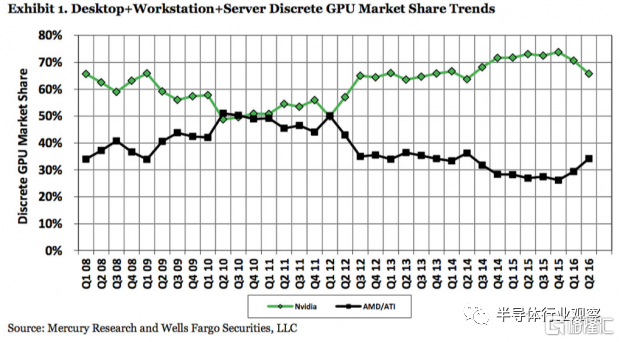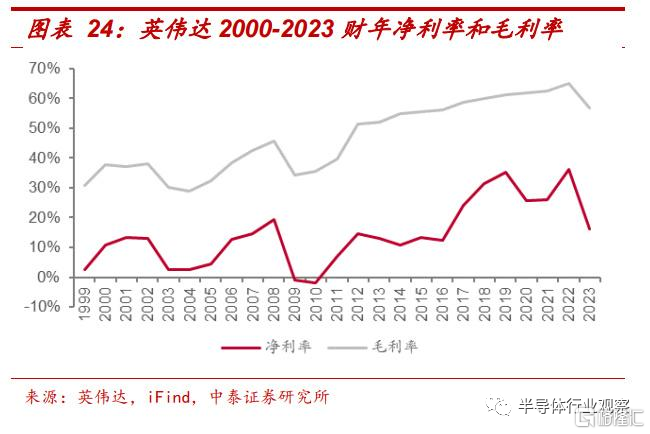This article comes from Gronghui column: semiconductor industry observation author: Shao Yiqi
On the morning of May 30, 2023, the Nasdaq Stock Exchange on the other side of the world, both buyers and sellers, laid down their work and began to stare at the screen on the wall, without the hour hand and minute second hand. But the air seemed to freeze because of the sound of breathing and heartbeats of different lengths and rhythms.
When screens flashed quickly and the numbers changed from 9:29:59 to 9:30:00, the air resumed, a burst of cheers broke out in the exchange, a few English letters appeared repeatedly on the computer, and today's topic was destined to belong to this company. and those excited people know that they have witnessed a new period of history.
Nvidia's (NVIDA) shares rose more than 4% on this day, with a total market capitalization of more than $1 trillion, making it not only the first chip company in the world with a market capitalization of more than $1 trillion, but also the fifth largest technology stock after Apple, Microsoft, Alphabet and Amazon.

CEO Huang Renxun has also become the focus of everyone's attention. he has been the main decision maker of Nvidia since 1993. Nvidia's ability to reach a market capitalization of trillions of dollars is inseparable from him as a founder.
However, even today, some people still wonder: why is it Nvidia?
Compared with Intel and AMD, Nvidia is more than 20 years younger, while GPU products all rely on contract manufacturers such as TSMC and Samsung, and it is difficult to compare with other semiconductor giants in terms of liquid assets and fixed assets.
Is it the re-creation of the myth in Silicon Valley, or is it the wrong view of Wall Street?
Nvidia is talking about its decisions over and over again about how it succeeded, but the crux of the problem is not what Nvidia did right, but how it made mistakes more meaningful before that, which is particularly important for semiconductor companies.
Nowadays, people don't like to talk about sunk costs, and they no longer care about the costs that cannot be recovered. as the so-called winners and losers, what the winners do is right, and the losers are worthless, and people only pay attention to the results and the moment. it's like driving a car with no rearview mirror and no brakes.
The parties obviously do not think so. on the eve of Nvidia's market capitalization about to break through trillion yuan, Huang Renxun, as an honorary doctor of National Taiwan University, was invited to attend the graduation ceremony of National Taiwan University and shared three failure stories in his speech. when everyone focused on his success and talked about his doubling of wealth, he thought of his dusty past.
From Tainan to Silicon Valley
Huang Renxun is not a Silicon Valley legend like Moore or Noyce. When he joined the business, Intel was already successful, Microsoft was already booming, and even AMD was a big semiconductor company.
Born in Tainan and emigrated to the United States at the age of 9, he and his brother spent two years in a rural boarding school in Kentucky. In an interview with USA Today, Huang Renxun recalled that he and his brother were at a naughty age, often climbing the roof, drilling windows, stealing candy, etc., and following the kids in the penitentiary, they learned all the dirty words. "everyone smokes, so so do I."
Two years later, he learned to be independent, adaptable and strong. With his parents officially moving to Oregon, he moved to a regular school and, like many Chinese children of his age, became obsessed with table tennis, and he was talented in this sport. he participated in the US Table Tennis Championships at the age of 15 and won third place in doubles in the US Table Tennis Open at the age of 15.
Had it not been for Huang Renxun's academic yearning, I am afraid he would have become a professional ping-pong player. After winning a good place in the Open, he chose to hang up, began to concentrate on his studies, and was admitted to Oregon State University at the age of 16, and from here on, his personal experience has taken on a touch of legend.

It is not difficult to understand that Huang Renxun chose to major in electrical engineering at Oregon State University. The revolution in the American semiconductor industry is in the ascendant, which was the hottest major of the year, and he finally got what he wanted. After graduating in 1983, he went to Silicon Valley and became an AMD chip engineer.
During his four-year college career, Huang Renxun gained not only knowledge, but also his first girlfriend and current wife Lori, who promised her that she would have a company of her own by the time she was 30.
And the most interesting thing is that after he moved to another chip manufacturer, LSI Logi, he served as an engineer, director of the business department, head of system integrated chips, and other positions. He also won a master's degree in electronic engineering from Stanford, and finally started his business in 1993. The company he founded was Nvidia. On February 17, 1993, Nvidia started business, which was Huang Renxun's 30th birthday. Perfectly fulfilled the promise he made at the age of 20.
And Huang Renxun chose nothing else for Nvidia, or the GPUs that we are familiar with today. According to Jon Peddie, an analyst in the chip industry shown by Bay Area, recalled: "at that time, Huang Renxun made a special phone call to ask about the trend of the display chip market and the future. I told him that this market has not yet started in a mess, and now there are nearly 30 companies. You'd better not do this. "
What were the changes in Silicon Valley in 1993? Intel has just launched the Pentium series of 80586 PowerPC AMD is the same with the previous 80486 processor, released Am486, the two processor giants are inextricably linked, while Apple and IBM are trying their best to promote the development of PowerPC, CPU is beginning to take shape.
But the future of GPUs is not clear: SGI, a pioneer in the graphics field, only provides graphics accelerators for some workstations; LSI Logi, its former employer, has not yet launched a special GPU chip; ATI, which is also founded by Chinese, has not come up with any specific products and has dawdled in the OEM market; Matrox, a veteran hardware manufacturer, has not fully joined the industry. The 3Dfx that set off the 3D revolution has not yet been established, and when the market is in chaos, it is a good time to start a business.
Huang Renxun eventually named the company Nvidia, although it originated from Invidia, the Roman name of the ancient Greek Titan god Nemesis, the mythical embodiment of hatred and jealousy, but he focused more on the first two letters N and V of the word, next version (next generation), representing his ambition to dominate future technological trends.
With six letters and a green eye, Nvidia embarks on a voyage of 3D graphics.
Two-fold halberd
However, as a hothead, Nvidia did not achieve the expected success, and its first mistake almost killed itself.
First of all, it should be explained that in 1993, there was no 3D graphics processing standard on the market, and the technical route we all took was different. Nvidia's choice was quadrilateral texture mapping, and its cost was relatively low. based on this technology, it released the first display chip product NV1 in 1995, which integrates graphics processing, sound card and game console interface and other functions, and is a more advanced product on the market.
But NV1, which took two years, quickly encountered the embarrassing situation that no one was interested in. The reason is very simple. Microsoft released Windows 95's Direct 3D standard in 1996, which is based on triangular texture mapping. Nvidia's NV1 is not compatible with this technology that is about to become the mainstream, which is tantamount to automatically abandoning the market for Windows computers. And in order to pursue profits, NV1 prices are not cheap, and sales are declining all the way.
The only good news at this time is that during the development of NV1, Nvidia's integration solution successfully attracted Sega, a game console manufacturer with higher cost requirements, and won an order for the graphics processing part of Saturn's next-generation host, Dreamcast, and the generous Sega paid US $7 million for research and development.
But Curtis Priem, Nvidia's chief technology officer, had an unimaginable obsession with doomed quadrilateral texture mapping, not only for NV1, but also for NV2, which was developed for Sega, regardless of the upcoming Direct 3D standard, which eventually led to the separation of the two companies.
Huang Renxun said frankly in his speech that Nvidia's architecture strategy at that time was already contrary to the trend of 3D graphics technology, and it was not too wrong to say that it was a big mistake. In addition to being not compatible with Windows, the actual game performance was also very mediocre. If you want to complete the contract, you must develop a GPU from scratch, and if you do not fulfill the contract, the capital of $7 million will instantly become the debt of this small 30-person company. It's only one step away from bankruptcy.
He chose to be honest. He told Sega's CEO that Nvidia's technology development was going in the wrong direction and Sega should hurry up to change partners, but the company urgently needed the money, and without Sega's investment, Nvidia would soon go bankrupt.
Fortunately, perhaps because Japanese companies value reputation, Shoichiro agreed to his request, not to cancel the contract between the two companies, but to use NV2 on the next generation of children's toy Sega Pico, while Invida temporarily got rid of the dilemma of bankruptcy and won six months of precious time.
In order to save Nvidia in the crisis, Huang Renxun also carried out a radical reform of the company, replaced with David Kirk (David Kirk), the chief technical officer and chief technology officer of Crystal Power, a console game manufacturer, to lead Nvidia's technology development team to face mainstream standards and tackle high-end GPUs. 3Dfx, which has already revolutionized 3D technology at this time.
In order to ensure production capacity, Huang Renxun also flew to Taiwan, where the manufacturing industry is developed, on the eve of the new product launch. taking advantage of his Chinese identity and relationship, he found Zhang Zhongmou, the head of TSMC, and reached cooperation with manufacturers such as graphics card motherboards. Invida received the last piece of insurance.
In April 1997, the third generation of Nvidia product NV3, Riva 128was officially launched, and Riva stands for "real-time interactive video and animation". Although it is difficult to compare the image quality with the hot 3dfx Voodoo at that time, Riva 128quickly won the favor of consumers and OEM manufacturers by virtue of its pixel filling rate in 100M/ seconds and its compatibility with Open GL. In less than a year, the shipments of Riva 128exceeded 1 million pieces.
Nvidia finally survived, and Huang Renxun's sentence "We are only 30 days away from bankruptcy" is not an exaggeration. At the beginning of the business, Nvidia has been struggling on the red line of bankruptcy and made mistakes in key decision-making. Almost ruined the young company.
Tripartite encirclement and suppression
After 1997, Nvidia started the mode of mass murder and successively launched Riva 128ZX, Riva TNT and Riva TNT2. A set of enhanced combination fists defeated all the display chip manufacturers on the market, and even the market leader 3dfx was losing ground. GeForce 256, launched in 1999, is known as the first GPU in the world. It is not only the first 256bit display chip, but also integrates 23 million transistors, which can handle at least 10 million polygons per second. Created a real-time graphics display standard for the personal computer industry.
On August 31, 1999, GeForce 256 was officially launched, and several giants of personal computers, including Dell, Gateway, Compaq and NEC, all announced that they would join GPU,IBM, which is pre-installed with Nvidia, the next day, and six major graphics card manufacturers also defected and made it clear that they would join the Nvidia camp.
Riding on the east wind of the personal computer, Nvidia can be as proud as you want. In 1999, Nvidia successfully listed on Nasdaq at an IPO price of $12 a share, then its share price soared to $70 a share, sales reached 440% of 1997, and its staff increased to 270, making it a Silicon Valley rookie reported in the newspapers.
Huang Renxun, who shows that the chip is going well, also puts forward a "Huang's law", that is, "Nvidia's core strategy is to upgrade the product every six months and double its function." This is three times faster than Moore's Law, which was proposed in 1965.
And Huang Renxun and Nvidia's vision is not limited to the corner of PC graphics card, although the previous cooperation with Sega finally aborted, but to another Sega partner to show their potential, this partner is none other than Microsoft, which once provided Windows CE system for Sega Dreamcast.
In addition, when Nvidia's GPU began to sell well, it also participated in the formulation of the DirectX standard. Although NV1 and NV2 did not use Microsoft's standard, it can be said that Nvidia has made great contributions to this standard after NV3. Without it, Microsoft may need to spend more time to popularize this standard.
Driven by these two main factors, Nvidia successfully won the largest order since its inception-the display chip for Microsoft's new game console Xbox. In March 2000, Microsoft announced that it would enter the game console market and compete directly with Nintendo and Sony, while the original console Xbox would carry GPU from Nvidia.
As soon as the news was announced, Nvidia's share price was on a roller coaster. You know, game consoles are different from the PC market. A best-selling game console, such as Nintendo's N64 and Sony's PlayStation, often sells tens of millions of dollars, while a single display chip only sells two or three million dollars, while Microsoft, as the world's largest technology company, isn't it easy to be a console? There was a lot of talk at that time, and Invida was really going to be rich now.
The generous Microsoft, in order to let Nvidia go all out to develop Xbox's GPU, directly paid a deposit of US $200m, with a total contract value of US $500m. At that time, Nvidia had annual sales of only US $500m, and then Microsoft handed over Xbox's media delivery processor (MCP) to Nvidia's research and development, which was regarded as a half-guarantee for the younger brother.
Microsoft Xbox was first released in the United States on November 15, 2001. its CPU uses Intel's Pentium 3, while GPU is a X-Chip specially customized by Invidia, and even the system is a simplified version of Windows 2000. It can be said that the Xbox is an x86 computer with not a low configuration.
In order to quickly enter the mainframe market, Microsoft finally set the North American price of the Xbox at $299. what is the concept? the GeForce 3 launched by Nvidia in February 2001 starts at $329, while the customized X-Chip is equivalent to an improved version of GeForce 3, that is to say, consumers can buy a fully equipped high-end PC at the price of a graphics card, and even support the newly launched Dolby 5.1.
Some analysts have estimated that Microsoft in the initial stage of Xbox, each sold one, the material cost may be a loss of 125USD, such a game, even if Microsoft is a big business, after burning money for a period of time also can not bear, and Xbox mainframe parts of the highest cost, that is, GPU and MCP, their prices even exceed Intel's Pentium 3, want to save costs, can not bypass Nvidia.
In April 2002, Microsoft formally proposed to Nvidia that it wanted to lower the supply price of GPU, but it was rebuffed by Lao Huang. The contradiction between the two companies on price broke out quickly and finally resorted to arbitration. At that time, Xbox chips accounted for 15% to 20% of Nvidia's business, and Nvidia's share price quickly ushered in an avalanche after the news of the breakup between the two companies.
Microsoft feels that Nvidia has made a lot of money by relying on its own DirectX standard, and this time it has paid 200 million US dollars in advance. now it is difficult for the game console business to develop, so your little brother should know better and lower the price a little bit, while Nvidia feels that producing chips for Xbox has led to a continuous decline in profit margins, and the price reduction is too much to deceive people. Do you believe it?
The tension between the two companies lasted until 2003, when not only Microsoft no longer regarded Nvidia as a close partner and strangled the idea of redesigning the next-generation mainframe Xbox 360. even Intel noticed the fast-growing display chip manufacturer and began to develop its own GPUs. At the same time, the two giants began to vigorously support Nvidia's biggest rival at that time, ATI, which is also a graphics card manufacturer. The three manufacturers launched a campaign against Nvidia.
For Nvidia, it really rained all night. Its share price fell to $7 from $70 in early 2002, and its market value shrank from $11 billion to $1 billion, and it was even more painful for Huang Renxun. The year before, he was selected by Fortune magazine's "40 millionaires under 40" and ranked 12th with a fortune of 507 million US dollars, and his personal wealth shrank tenfold the following year. Originally a billionaire, he became a multimillionaire after some upheaval.
In an interview with Wired magazine at the end of the year, he once again admitted that "Nvidia has made a serious mistake, but if all great companies have one thing in common, it is to be able to realize that they have made a mistake."
sleep on the brushwood
In the face of encirclement and suppression, Nvidia had no choice but to bow to Microsoft. It formally reached a settlement with Microsoft in February 2003, and then reached a cooperation to use Microsoft MCE media player software to bundle and sell Nvidia graphics chips. in 2003, Xbox began to sell well, and GPU production costs gradually dropped, finally making Nvidia's life a little easier.
To recover from the loss of Xbox 360s, Nvidia also reached a partnership with Sony at the end of 2002 to provide display chips for the next-generation game console PlayStation3, a relief from its old rival ATI to win orders for two new-generation game consoles, Microsoft and Nintendo.
At the same time, Nvidia released its sincerity to Intel. At the end of 2003, it was reported that Nvidia was preparing to make the Nforce chipset compatible with Intel's Benz 4 Prescott. At the CES Technology Show in January 2004, Nvidia first showed the display chipset using PCIE, and then fully supported Intel PCIE standard. In November of that year, Nvidia and Intel formally reached a mutual licensing agreement to exchange patents and chip licenses. Two tit-for-tat companies were reconciled.
Of course, Nvidia knows very well that iron striking still needs to be hard on its own. since 2004, Huang Renxun summed up his experiences and lessons in product development. in order to make a technological breakthrough faster, Nvidia adjusted the design team of each new product to 30 or 40 people. and come from different disciplines, and even intend to arrange the matching of engineers from different companies for inspiration collision.
Such an adjustment will take effect quickly. In April 2004, at the semi-annual product update conference, Nvidia officially launched the GeForce 6800 series, with 220 million crystal integration, more than twice the performance of the previous generation, easily surpassed the 9800 series of ATI, and quickly gained the upper hand in the consumer electronics market.
At this time, its biggest rival ATI broke the news that it was about to be acquired by AMD. Huang Renxun, who heard the news, immediately said that this is good news for Nvidia and it is pie in the sky.
"ATI is going to throw in the towel. Let's become the only independent graphics chip company in the world." He said.
As for what he really thinks, there may be more mixed tastes. Some former AMD employees revealed that AMD initially did not consider Nvidia, which has a more obvious market advantage, but Huang Renxun insisted that he be the CEO of the merged company. In the end, AMD chose Nvidia's rival ATI.
Of course, his optimism came a little too early. After AMD integrated ATI, he launched several counter-attacks, and even briefly surpassed Yingwei to become the market leader during the period from 2010 to 2012. This GPU battle is inextricable.

The opportunity to change everything came in 2007, when Nvidia held the first CUDA (Compute Unified Device Architecture) Technology Conference in Santa Clara, California, a parallel computing platform and programming model that allows developers to write GPU-accelerated applications in programming languages such as C, C + +, Fortran, and so on.
The initial development of CUDA was not smooth. After all, the establishment of a model requires a huge developer base. In order to solve the problem of chicken or egg, Nvidia finally chose to use the game GPU, that is, GeForce, to build the hardware foundation and take advantage of a sufficient number of game players to promote the development of CUDA.
But CUDA also needs more cost support, and even caused the third crisis in the development of Nvidia. After reading Nvidia's earnings report, we can find that Nvidia's net profit and gross profit fell sharply after 2008, even a loss, when Nvidia's market capitalization was just over $1 billion. Even shareholders doubt the correctness of CUDA.

Fortunately, Nvidia's game GPU business developed well at this time, and the PS3 carrying Nvidia GPU also began to sell well after the price reduction, and the two provided a valuable blood transfusion channel for Nvidia's research and development of CUDA, allowing it to survive this difficult period. At the same time, it began to hold a GTC conference to promote CUDA technology around the world.
The real turnaround appeared in 2012, when AI researchers discovered CUDA, they found that the massively parallel computing chip Tesla based on CUDA architecture has a natural fit in artificial intelligence and deep neural network technology, which greatly reduces the difficulty of training high-power models such as neural networks. at this time, Nvidia, which provides computing infrastructure, finally ushered in the dawn of victory after years of suffering.
Today, 10 years later, Nvidia has been equated with AI. When it comes to AI development, Nvidia is doomed to avoid Nvidia, a chip company, which is already the biggest power engine for AI development.
Of course, Nvidia's bet is not just on CUDA.
Before 2012, Nvidia, looking for new growth points, aimed at the emerging smartphone market and launched a series of Tegra mobile chips. the first product was Microsoft's Zune HD media player launched in September 2009. At that time, there were already competitors such as Qualcomm, MediaTek and Texas Instruments in the market, and Nvidia's idea was simple: Arm's public CPU architecture plus its own high-performance GPU, as long as people have demand for mobile games. Tegra can have a place at the top end of the market.
From the early Tegra APX 2500 to the famous Tegra 3, Nvidia once won a large share of the smartphone market, but the problem also ensued. Nvidia does not have its own baseband and needs to buy additional from other manufacturers, while the self-developed mobile GPU seems to have strong performance, but the power consumption is also not small, and the performance of the terminal products equipped with Tegra chips is not good.
Within a few years, the number of customers for Tegra chips had shrunk from dozens to single digits, and by the Tegra X1 in 2015, no other manufacturers were willing to install Nvidia's mobile chips except Nintendo's Switch, Google's Pixel C tablet and Nvidia's Shield TV.
This is also another fiasco for Nvidia, fortunately, the Tegra series of products are not only suitable for mobile products such as mobile phones, but early on were carried by Tesla Model S and other cars as the main control chip of the car machine. Nvidia saw that the mobile market did not make a name for itself, so it completely transformed the Tegra into a car machine and self-driving chip, which belonged to a decent strategic transfer.
Of course, Nvidia has never given up its desire for the big cake of the mobile market, otherwise it would not have announced the acquisition of Arm in September 2020, and this year, Nvidia also signed a partnership with MediaTek to integrate Nvidia's GPU on MediaTek's flagship SoC, hoping to prove itself once again in the mobile market.
AI, cars and mobile may be a new chapter in the Nvidia story over the next decade.
parade with beautiful dress at night
Looking at dozens of large semiconductor companies in Silicon Valley, Huang Renxun of Nvidia CEO is also one of the most high-profile and people-friendly.
He rarely missed Nvidia's product launches, always dressed in black leather and often made amazing comments, but it was his usual style to dare to do it. He bet his colleagues that Nvidia's share price was over $100, so he went to get a Nvidia Logo tattooed on his body. He also said that the tattoo was "like a child" because of the pain.
When Nvidia's market capitalization was rising at the end of last year, Huang Renxun showed up in Taiwan, dressed in familiar black leather, into the street studio of two young singers and asked for a Lady Gaga song with a curious look on his face.
In his speech to graduates of National Taiwan University, he summed up the experiences and lessons brought about by three mistakes, namely, facing mistakes in the early days of starting a business, having the courage to ask for help, insisting that CUDA must endure pain in order to realize its vision, and giving up the strategic withdrawal of the mobile market, deciding what not to do.

These three words of advice run through the 30-year history of Nvidia, so when we talk about Nvidia's success today, we are doomed to avoid previous failures and setbacks. Unlike other semiconductor companies, Nvidia seems to regard this part of the mistake as a scar on a man's body and is never ashamed to mention it. Huang Renxun also said that he has experienced several very great failures, which are full of humiliation and embarrassment. But it is these failures that define what Nvidia is today.
Without the failure of NV1 and NV2, perhaps Nvidia would not have understood the importance of following more advanced standards; without the encirclement and suppression of Xbox, Intel and ATI, Nvidia may still be the enemy of the world today, and without strategic decisions from CUDA and the mobile market, Nvidia might not be able to make a difference in the field of autopilot and AI.
Mistakes are the bones that support Nvidia, and the soul is naturally CEO Huang Renxun. He is to Nvidia what Noyce is to Intel and Saunders is to AMD. Since its birth, he has put a deep personal imprint on this company.
Huang Renxun's last message to graduates is to run to prey, or to run hard to avoid becoming a predator's food. a sentence reveals the nature of the cruel competition in the semiconductor industry. if he cannot become a predator, it will become food. he, who has won in more than 30 graphics chip companies, knows this very well.
And Invid finally stood at the top of the food chain, in addition to the above-mentioned rapid adjustment to mistakes, there is also the meaning of this sentence, which never stops running, just like Forrest Gump, who is constantly running in the movie Forrest Gump. If you stop, you will be surpassed by later people, and only by moving forward can you keep seizing new opportunities.

To everyone's surprise, on the eve of Nvidia's soaring market capitalization, Huang Renxun went to the Taipei night market and wandered around with a bag of twist. At this time, he may think of Xiang Yu's exclamation: wealth does not return to its hometown, such as clothes embroidery at night, who knows.



